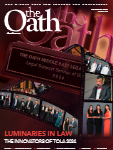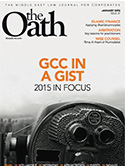Proving your Worth 4

How can a general counsel achieve success in the board room? Bernadette Baynieshares her best practice tips.
Organisations today live in fast paced world of regulation, industry competition and digitisation. GC’s need to be on top of their game, in relation to their own work, to obtain the best decision making form their boards, when it matters the most. They need to have the skills, know-how and experience that will enable them to do so. Here are some tips on how a GC can achieve a track record of success with their boards when presenting to them on high priority topics requiring fast decision making. It’s all about empathy, enablement and preparation!
1. Rule No 1 – Be empathetic and enabling when preparing your board presentations
§ Never go to a board meeting without having a compelling reason for doing so. Their time is precious, so respect it.
§ Be “empathetic” and put yourself in the shoes of your board directors when preparing your presentation. What information would you want to know if you had to make the decision that you are seeking from them and then be personally liable for it?
§ Your presentation should set out clearly and concisely the reasons for the decision that you seek and all relevant information that will “enable” your board to make an informed and prompt decision about it.
§ Add information which highlights the various risks involved in the decision to be made and the factors that will mitigate or eliminate it.
§ Your presentation should be so compelling that by the end of it each board director should have the “Ahh! Of course moment”, which readily grants you approval for the board resolutions that you seek.
§ To do so reduce yourkey messages in your presentation to no more than three or four. You may lose them with more. This may appear difficult initially as lawyers are trained to give “more than less “ but you will be genuinely surprised with the result if you do.
§ To captivate their attentionput such messages first in an executive summary slide in simple and easy to read words and follow this with a brief slide of the“relevant background”. Thisexplains the context of “why” your key messages have arisen and the reason for their “importance” and decision making “on the day”.
§ Don’t intimate your board member with a lengthy slide pack. Limit your main slides to four-six and state simply in bullet points what you really need to say.
§ A highly effective approach is to put everything else in a separate and “supplementary slide pack” with all relevant annexures.They will read it out of inquisitiveness and professional completeness – but will not feel intimated in the process.
§ Always circulate your presentations earlyas you will gain a credible reputation by your board directors for being considerate towards them.
2. Rule No 2 – Slow right down when presenting
§ Enter the board room positively with confidence and smile on your face.Always shake the hands of each director (if your board room protocol permits).
§ Take a deep breath and pause for a few seconds before you speak…this will instinctively demonstrate that you are confident and in control of the topic that you are presenting.
§ Emphasis what you are saying by speaking intentionally and slowly – so that there are a few seconds between each of your words. Your directors are likely to “hang on to such words” and your underlying messages from them. It really works!
3. Rule No 3 – Bond with your board by speaking “with” them and not “at” them
§ To obtain an instant personal connection look into the eyes of each director around the boardroom intentionally during your presentation. Give them an entire key message or sentence, without breaking your gaze upon them. Then move onto the next director…etc
§ Give certain questions prominence by saying “Thank you for raising it. It is a highly relevant question to this matter” and then respond as confidently and succinctly as possible. You will make that director feel important and engage him/her more readily…and lift other board directors’ engagement at the same time.
Putting these key steps into action will aid and enable you, as a GC, to achieve pivotal decision from your board making when it matters the most!
Columnist:
Bernadette Baynie, group general counsel, Batelco Group
























































































































